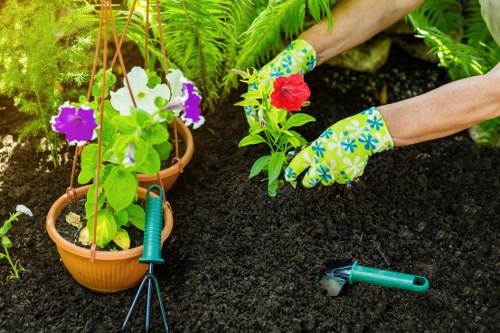Hedge Trimming in Southfields

Hedge trimming is an essential aspect of maintaining a beautiful and healthy garden in Southfields. Whether you're a homeowner looking to enhance your outdoor space or a professional landscaper seeking to offer top-notch services, understanding the nuances of hedge trimming can make a significant difference. In this comprehensive guide, we'll explore the best practices, benefits, and tips for effective hedge trimming in Southfields.
Maintaining hedges not only enhances the aesthetic appeal of your property but also promotes the health and longevity of the plants. Proper hedge trimming encourages dense growth, prevents diseases, and keeps your garden looking well-kept year-round. In Southfields, where gardens are a pivotal part of the community's charm, mastering hedge trimming techniques is invaluable.
In this article, we'll delve into the different types of hedges suitable for Southfields gardens, the tools required for trimming, seasonal considerations, and professional services available. Whether you're a seasoned gardener or a beginner, this guide will provide you with the knowledge needed to achieve pristine hedges.

Types of Hedges Suitable for Southfields
Choosing the right type of hedge is crucial for achieving the desired look and functionality in your Southfields garden. The climate, soil conditions, and maintenance requirements all play a role in selecting the perfect hedge.
Common Hedgerows in Southfields Include:
- Boxwood (Buxus): Known for its dense foliage and ease of shaping, boxwood is a popular choice for formal gardens.
- Privet (Ligustrum): Fast-growing and versatile, privet hedges can be trimmed into a variety of shapes and sizes.
- Holly (Ilex): With its glossy leaves and bright berries, holly adds both beauty and wildlife interest to your garden.
- Laurel (Prunus): Laurel hedges are sturdy and evergreen, providing excellent privacy and windbreaks.
- Yew (Taxus): Yew is a classic choice for traditional gardens, offering dense growth and tolerance to heavy pruning.

Essential Tools for Hedge Trimming
Having the right tools is fundamental to achieving a clean and efficient hedge trim. Investing in quality equipment can save time and ensure the health of your hedges.
Must-Have Hedge Trimming Tools:
- Pruning Shears: Ideal for small branches and precise cuts.
- Hedge Trimmers: Electric or manual trimmers are essential for larger hedges.
- Loppers: For thicker branches that shears cannot handle.
- Gloves: Protect your hands from thorns and sharp edges.
- Ladder: Necessary for reaching higher sections of tall hedges.
- Safety Glasses: Ensure eye protection during intensive trimming.
- Rake: To clear debris and maintain a tidy garden edge.

Seasonal Considerations for Hedge Trimming
Timing your hedge trimming activities according to the seasons can significantly impact the growth and health of your hedges. Southfields experiences a temperate climate, allowing for versatile trimming schedules.
Spring Trimming
Spring is an excellent time to give your hedges a light trim, encouraging new growth and maintaining shape after the winter months. Avoid heavy pruning during this period to prevent stress on the plants.
Summer Trimming
Regular maintenance during the summer ensures that hedges remain dense and vibrant. Be cautious of the heat, and trim during cooler parts of the day to prevent wilting.
Autumn Trimming
Late autumn trimming can help prepare hedges for the winter by removing any damaged or diseased branches. However, avoid heavy pruning right before the first frost to allow time for healing.
Winter Trimming
In mild winters, hedge trimming can be performed carefully. For areas with harsh winters, it's best to avoid trimming until early spring to protect the hedges from frost damage.

Professional Hedge Trimming Services in Southfields
While DIY hedge trimming is feasible, hiring professional services can ensure precision and save you time. Professionals bring expertise, the right tools, and the ability to handle large or complex hedges efficiently.
Benefits of Hiring Professionals:
- Expertise: Professionals understand the specific needs of different hedge types and can tailor their trimming techniques accordingly.
- Time-Saving: Outsourcing hedge trimming allows you to focus on other aspects of garden maintenance.
- Safety: Professionals are trained to handle equipment safely and manage height-related risks effectively.
- Healthier Hedges: Proper trimming by experts can prevent diseases and promote robust growth.
Choosing the Right Service Provider
When selecting a hedge trimming service in Southfields, consider the following factors:
- Experience: Look for companies with a proven track record and positive customer feedback.
- Licensing and Insurance: Ensure that the service provider is licensed and carries adequate insurance to protect against potential damages.
- Range of Services: Choose a provider that offers comprehensive services, including pruning, shaping, and maintenance plans.
- Pricing: Compare quotes from multiple providers to find competitive rates without compromising on quality.
- Sustainability: Opt for companies that use eco-friendly practices and sustainable materials.
Top Hedge Trimming Companies in Southfields
Several reputable companies in Southfields specialize in hedge trimming services. These professionals are equipped to handle various hedge types and sizes, ensuring your garden remains pristine year-round.
Local Expertise
Local companies understand the specific climate and soil conditions of Southfields, allowing them to provide tailored solutions for your hedges.
Customer Satisfaction
High levels of customer satisfaction are a testament to the quality and reliability of a hedge trimming service. Look for companies that prioritize client needs and deliver consistent results.
DIY Hedge Trimming Tips
For those who prefer a hands-on approach, DIY hedge trimming can be rewarding and cost-effective. Here are some essential tips to ensure successful trimming:
- Plan Your Trim: Determine the desired shape and size before starting. Use string lines or stakes to mark guidelines if necessary.
- Use Sharp Tools: Ensure all trimming tools are sharp and clean to make precise cuts and prevent damage to the plants.
- Trim Regularly: Regular maintenance prevents overgrowth and reduces the effort required for each trimming session.
- Cut at the Right Angle: Make angled cuts to allow water runoff and promote faster healing of the cut branches.
- Dispose of Debris: Clear away trimmings to maintain a tidy garden and prevent the spread of pests and diseases.
Safety Precautions
When trimming hedges, always prioritize safety to prevent accidents and injuries:
- Wear Protective Gear: Gloves, safety glasses, and sturdy footwear are essential protective equipment.
- Use Ladders Safely: Ensure that ladders are stable and properly positioned before climbing.
- Be Mindful of Power Tools: If using electric or battery-operated trimmers, follow manufacturer instructions and handle tools with care.
- Stay Hydrated: Gardening can be physically demanding, so drink plenty of water, especially during hot weather.
Common Mistakes to Avoid
Avoid these common pitfalls to ensure healthy and aesthetically pleasing hedges:
- Over-Trimming: Cutting back too much can stress the plant and stunt its growth.
- Ignoring Plant Health: Trimming unhealthy or diseased branches can prevent the spread of issues.
- Improper Tool Maintenance: Dull or dirty tools can cause rough cuts and damage the hedge.
- Neglecting Seasonal Needs: Each season has specific trimming requirements to support plant health.
- Lack of Planning: Trimming without a clear plan can lead to uneven or irregular shapes.
Benefits of Regular Hedge Trimming
Regular hedge trimming offers numerous advantages that contribute to the overall health and appearance of your garden:
- Enhanced Curb Appeal: Well-maintained hedges create an inviting and attractive outdoor space.
- Increased Privacy: Dense and properly trimmed hedges provide effective privacy screens from neighbors and passersby.
- Improved Plant Health: Trimming removes dead or diseased branches, promoting healthier growth and reducing the risk of infestations.
- Weed Control: Keeping hedges trimmed helps prevent weeds from taking hold and competing for nutrients.
- Safety: Overgrown hedges can obscure pathways or create fire hazards by restricting airflow.
- Property Value: A well-maintained garden can enhance the value of your property, making it more appealing to potential buyers.
Environmental Benefits
Beyond aesthetic and practical advantages, regular hedge trimming also supports environmental health:
- Biodiversity: Healthy hedges attract a variety of wildlife, including birds, insects, and beneficial predators.
- Air Quality: Lush hedges contribute to better air quality by absorbing pollutants and producing oxygen.
- Climate Regulation: Dense hedges can act as windbreaks, reducing energy consumption for heating and cooling.
Long-Term Cost Savings
Investing in regular hedge maintenance can lead to long-term savings by preventing costly repairs and replacements. Healthy hedges require fewer resources and are less likely to suffer from severe damage that necessitates extensive intervention.
Sustainable Gardening Practices
Incorporating sustainable practices in hedge trimming not only benefits your garden but also the broader environment:
- Use Eco-Friendly Tools: Opt for manual or electric trimmers over gas-powered ones to reduce emissions.
- Compost Organic Waste: Utilize trimmings for compost, enriching your garden soil naturally.
- Water Conservation: Prune hedges to improve airflow and reduce the need for excessive watering.
Maintaining Hedge Health
Ensuring the longevity and vitality of your hedges requires more than just regular trimming. Proper care and maintenance practices contribute to robust growth and resilience against diseases.
Watering and Fertilizing
Adequate watering and fertilization support the overall health of your hedges:
- Watering: Provide consistent moisture, especially during dry spells. Early morning watering is ideal to reduce evaporation and prevent fungal diseases.
- Fertilizing: Apply balanced fertilizers in the growing season to supply essential nutrients. Avoid over-fertilizing, which can lead to excessive growth and weak branches.
Pest and Disease Management
Regular inspections help identify and address pest and disease issues promptly:
- Identify Common Pests: Watch for signs of insects like aphids, caterpillars, and mites that can damage your hedges.
- Natural Remedies: Utilize organic treatments and beneficial insects to control pest populations without harming the environment.
- Pruning Affected Areas: Remove and dispose of any diseased or infested branches to prevent spread.
Soil Health
Healthy soil is the foundation for strong hedges. Regularly amend your soil with organic matter, such as compost or well-rotted manure, to improve structure and fertility.
Mulching
Applying mulch around your hedges conserves moisture, suppresses weeds, and regulates soil temperature. Choose organic mulches like bark, straw, or wood chips for added benefits.
Innovative Hedge Trimming Techniques
Advancements in gardening techniques offer new methods for more efficient and effective hedge trimming. Embracing these innovations can enhance the quality of your hedges while saving time and effort.
Topiary Trimming
Topiary involves shaping hedges into artistic and geometric forms, adding a unique and elegant touch to your garden. This technique requires precision and regular maintenance to maintain intricate designs.
Power Trimming Tools
Modern hedge trimmers come with enhanced features like ergonomic designs, adjustable blades, and battery-powered options, making the trimming process smoother and less strenuous.
Automated Trimming Systems
For large estates or commercial properties in Southfields, automated hedge trimming systems can provide consistent cutting with minimal manual intervention. These systems are programmable and can maintain hedges with uniform precision.
Eco-Friendly Trimming Practices
Integrating sustainable practices into your trimming routine reduces environmental impact:
- Solar-Powered Tools: Utilize solar-powered trimmers to minimize energy consumption.
- Recycling Trimmings: Convert hedge clippings into mulch or compost to recycle nutrients back into the soil.
- Water-Efficient Techniques: Implement watering practices that reduce water usage while keeping hedges healthy.
Digital Planning Tools
Use digital apps and tools to plan and track your hedge trimming schedule. These tools can help you stay organized, set reminders for seasonal trims, and monitor the growth patterns of your hedges.
Common Questions About Hedge Trimming in Southfields
Addressing common queries can help you better understand and execute effective hedge trimming practices:
How often should I trim my hedges?
Generally, hedges should be trimmed 2-3 times a year: early spring, late summer, and late autumn. However, the frequency may vary based on the hedge type and growth rate.
What time of day is best for trimming?
The best time to trim hedges is in the late morning or early afternoon when the plants are fully hydrated. Avoid trimming during the peak heat of the day to reduce stress on the plants.
Can I trim my hedges myself?
Yes, with the right tools and knowledge, DIY hedge trimming is achievable. However, for large or complex hedges, professional services might be more efficient and precise.
What are the signs my hedges need trimming?
Signs include overgrown branches, irregular shapes, sparse foliage, and the presence of dead or diseased sections.
Should I water my hedges before trimming?
Watering your hedges a day before trimming can help reduce stress and make the plants more receptive to pruning.
Expert Tips for Beginners
If you're new to hedge trimming, consider these beginner tips:
- Start Small: Begin with less complex hedges to build your confidence and skills.
- Educate Yourself: Learn about the specific needs of your hedge types, including preferred shapes and trimming techniques.
- Invest in Quality Tools: High-quality, sharp tools make trimming easier and more effective.
- Take Your Time: Approach trimming methodically to avoid mistakes and ensure even cuts.
- Seek Guidance: Don't hesitate to consult gardening resources or professionals if you're unsure about certain techniques.
Conclusion: Elevate Your Garden with Expert Hedge Trimming
Effective hedge trimming is a blend of art and science, requiring attention to detail, the right techniques, and consistent maintenance. In Southfields, where gardens are a source of pride and relaxation, mastering hedge trimming can transform your outdoor space into a stunning and inviting environment.
Whether you choose to undertake the task yourself or hire professional services, understanding the principles of hedge trimming ensures that your hedges remain healthy, beautiful, and functional throughout the year.
Don't wait to enhance your garden—contact us today to book your hedge trimming service and experience the difference expert care can make.
Ready to Transform Your Garden?
Book your service now and let our experienced team in Southfields take care of all your hedge trimming needs. Achieve the garden of your dreams with precision and expertise.